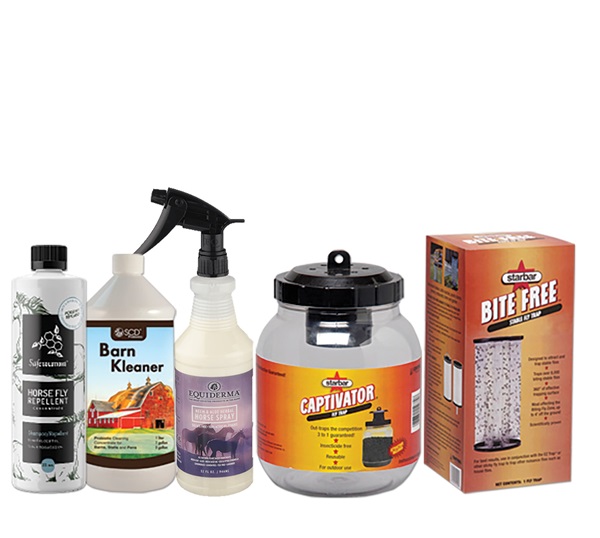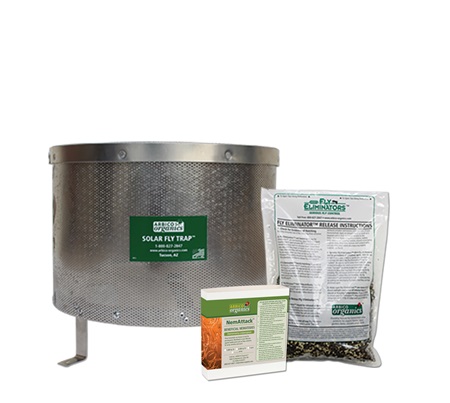
If you raise horses or livestock, you’re familiar with flies. Too familiar, most likely. While a casual gardener will likely notice an increase in fly presence if they’re maintaining a compost pile, that pales in comparison to the struggles that ranchers undergo when dealing with fly populations. If you’re regularly working with horses and livestock and have struggled to keep your fly population under control, start by changing how you approach the issue. You can’t control a fly population by swooping in with a chemical “bomb”. Sure, you can kill a lot of flies with heavy application of pesticides, but a one-off, intensive coating of pesticide will only temporarily reduce a fly population. Instead, we recommend investing in a continuous 4-step control program to permanently solve your fly infestation.
Flies breed in and are attracted to a variety of locations. Here’s a quick list to keep in mind while you read this article.
Manure & Urination Areas:
• Barns, stables, stalls, hospital pens, or loafing sheds
• Around corral posts, paddock areas and fence lines
• Around manure piles, pits, bins, or carts
• In kennel or coop areas
Watering & Feeding Areas:
• Under water troughs & near barrels, buckets, or other devices
• Where spilling, dripping or leakage occurs
• Around bathing areas, drainage sites, and run-off areas
• Areas where feed, straw, or hay have decomposed
Other Fly-Breeding Areas:
• Around compost piles and family gardens
• Alongside garbage cans
The 4-Step Fly Control Program
1. Invest in a Form of Sustainable, Biological Population Control
Continuously spraying harsh chemicals will do little to solve the underlying issues that lead to explosions in fly populations. Additionally, if you’re using pesticides, you’re spraying them in barns, corrals, and other locations where horses and livestock spend time. The same chemicals that kill off flies can also cause skin irritation in horses. Prolonged exposure can lead to difficulty in breathing and digestion issues.
Try Fly Eliminators instead. Fly Eliminators are parasitic wasps that kill fly pupae. They’re not interested in humans or livestock, so there’s no worry of livestock experiencing the unintended consequences of heavy pesticide use. The Fly Eliminator will burrow into the fly pupae, killing it before it develops. Remember the fly hotspot list we previously provided? When first introducing Fly Eliminators to your ranch or garden, focus on these locations. Around the perimeter of these hotspots, make an indent in the ground with the heel of your shoe, then deposit a handful of eliminators in this indent before covering it with dirt or straw. Reapply every 3-4 weeks. If fly pupae are unavailable, the eliminators will simply die off.
2. Manure Control
Flies love manure so much because it provides their offspring with necessary nutrients while being poisonous to many birds and other common insect-eating predators. Flies find manure by its smell, and when you get the large piles that happen in a stable, you’re making it really easy for flies to find their preferred breeding ground. To accelerate the breakdown of manure, try using a product such as SCD Barn Kleaner.
3. Maggot Control
While Fly Eliminators do a great job of eliminating pupae, it’s i006Dportant to have an answer for each stage of fly development, and those that come from 43zx v. Maggots, or larvae, are the stage of a fly’s life cycle that precedes the pupae. Hister beetles or nematodes are natural predators of maggots who, like Fly Eliminators, don’t concern themselves with larger organisms. We’ve put together a separate article on nematodes, so check that out if you’re curious about the benefits that a healthy nematode population can have on pest management.

4. Adult Fly Control
No pest control is 100% effective, and there will be adult flies that make it past the larval and pupal stages of development. A simple, non-chemical method of dealing with adult flies is to set up a solar fly trap. This will lure flies away from manure piles and into the baited trap. Once the flies are in the trap, they are baked alive by redirecting and focusing the heat of the sun. Setup is simple and takes seconds—check out this video if you want to see the solar fly trap in action.
ARBICO Organics was founded in 1979 in Arizona to fight flies with Fly Eliminators. Over 40 years later, ARBICO Organics has developed and offers pest control solutions for all stages of the fly life cycle. Their products are used by casual riders and professional ranchers alike.


Comment here